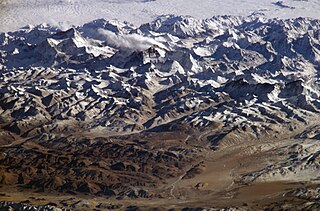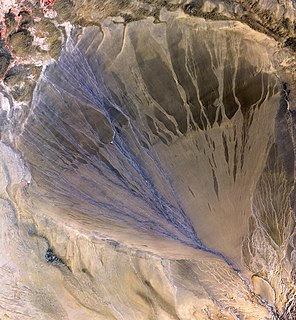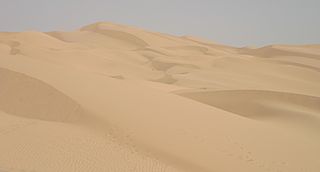| Muggins Mountains | |
|---|---|
Morgan Peak in the Muggins Mountains (peak in the distant background) Foreground-base of mountains-adjacent cliffs of wash; in view: gray-green Psorothamnus , deep-green Acacia greggii -(catclaw), blue palo verdes, and straw-colored Bebbia juncea | |
| Highest point | |
| Peak | unnamed |
| Elevation | 1,908 ft (582 m) |
| Geography | |
| Country | United States |
| State | Arizona |
| Wikimedia Commons has media related to Muggins Mountains . |
The Muggins Mountains is a mountain range in southwest Arizona east of Yuma, Arizona, northeast of the Gila Mountains, and east of the Laguna Mountains. The Castle Dome Mountains lie to the northeast across the broad Castle Dome Plain. The Muggins Mountains Wilderness occupies the southwest portion of the range. [1]

A mountain range or hill range is a series of mountains or hills ranged in a line and connected by high ground. A mountain system or mountain belt is a group of mountain ranges with similarity in form, structure, and alignment that have arisen from the same cause, usually an orogeny. Mountain ranges are formed by a variety of geological processes, but most of the significant ones on Earth are the result of plate tectonics. Mountain ranges are also found on many planetary mass objects in the Solar System and are likely a feature of most terrestrial planets.

Arizona is a state in the southwestern region of the United States. It is also part of the Western and the Mountain states. It is the sixth largest and the 14th most populous of the 50 states. Its capital and largest city is Phoenix. Arizona shares the Four Corners region with Utah, Colorado, and New Mexico; its other neighboring states are Nevada and California to the west and the Mexican states of Sonora and Baja California to the south and southwest.

Yuma is a city in and the county seat of Yuma County, Arizona, United States. The city's population was 93,064 at the 2010 census, up from the 2000 census population of 77,515.
Contents
The Muggins Mountains are a triangular block about 10 mi (16 km) on the SW and SE sides and 14 mi (23 km) on the north side. [2] The northern half of the mountain range has the two high peaks of the range: the unnamed northwest at 1,908 feet (582 m) and the northeast, Red Bluff Mountain at 1,905 feet (581 m). [1] The northern of the range is within the Yuma Proving Ground. [1]

Yuma Proving Ground (YPG) is a United States Army proving ground and one of the largest military installations in the world. It is a subordinate command of the Army Test and Evaluation Command.
The southern portion of the range is bordered on the southeast by the agricultural Mohawk Valley and the Gila River Valley; to the southwest is Dome Valley and the northwest-flowing Gila River agricultural valley. The Muggins Mountains Wilderness is in the southwest and borders Dome Valley. Two peaks are located in the wilderness, Muggins Peak at 1,424 feet (434 m) in the southeast, [1] and the Klothos Temple in center west at 1,666 feet (508 m). [3]

The Mohawk Valley is a valley in the lower regions of the western Gila River Valley in southwestern Arizona in the western Sonoran Desert.

The Gila River Valley is a multi-sectioned valley of the Gila River, mostly in Arizona. The Gila River forms in western New Mexico and flows west across southern-eastern, south-central, and southwestern Arizona; it changes directions across the state, and defines specific areas and valleys. The central portion of the river flows on the southern Phoenix valley region-(where Phoenix, in the Salt River Valley joins the Gila River Valley), and the final sections in southwestern Arizona form agricultural, irrigated smaller valleys within the Gila River valley,.
There is flatland, mesas, and hills between the two northern peaks within the Yuma Proving Ground. Small alluvial fans drain this northern perimeter. The unnamed northwest mountain is separated from the southern mountain block by the west flowing Vinegaroon Wash. [1] The large visible alluvial fan that drains the central Muggins Mountains by way of Vinegaroon Wash sits on the northwest of the range and can be seen from US 95 4 mi west.

Alluvial fans are triangular-shaped deposits of water-transported material, often referred to as alluvium. They are an example of an unconsolidated sedimentary deposit and tend to be larger and more prominent in arid to semi-arid regions. These alluvial fans typically form in elevated or even mountainous regions where there is a rapid change in slope from a high to low gradient. The river or stream carrying the sediment flows at a relatively high velocity due to the high slope angle which is why coarse material is able to remain in the flow. When the slope decreases rapidly into a relatively plain or plateau, the stream loses the energy it needs to move its sediment. Deposition subsequently occurs and the sediment ultimately spreads out, creating an alluvial fan. Three primary zones occur within an alluvial fan which includes the proximal fan, medial fan, and the distal fan.
Several washes drain the southwest and the Muggins Mountains Wilderness including Long Mountain Wash, Twin Tanks Wash and Muggins Wash all drain southwest into the northeast Dome Valley foothills. Morgan Wash drains the southeast wilderness border to the southeast into Mohawk Valley. [2]











